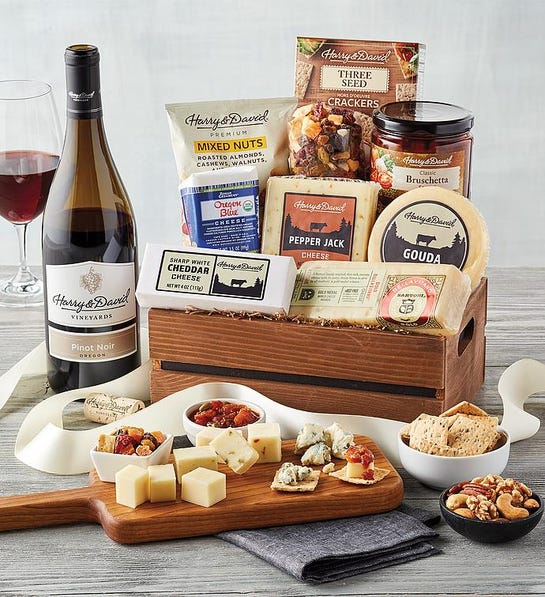Deluxe Cheese Crate with Wine | Harry & David
Order the Deluxe Cheese Crate with Wine from Harry & David. For more than 80 years, delivered expertly crafted delight.
Treat someone special to a thoughtfully chosen collection of gourmet cheeses. Included in this assortment are nutty, Italian-inspired Sartori® BellaVitano® Gold cheese; tangy and savory Rogue Creamery® Oregon Blue cheese; Beehive Jivin’ Chive cheese curds featuring dried chives; and even more exceptional selections. These five premium cheeses are accompanied by dried fruit, mixed nuts, three-seed crackers, and garlic-stuffed olives. It all arrives in a branded wooden gift crate with rope handles, as well as a bottle of refreshing Harry & David™ Pinot Noir.
Additional information
| Contents | – Sartori®: BellaVitano®: Gold cheese (5.3 oz) |
|---|


by Jennifer
I sent this to someone so I’m not sure of how everything tastes but the receiver was very happy with everything that they saw!
by Mike
We sent this to our in-laws and they loved it.
by Meghan
Such a beautiful layout and display as a gift. So classy and so perfect for entertaining!
by Gary
Everything in the package was delicious and plentiful. We were very happy! We couldn’t wait for Christmas and didn’t!!
by Maria
As advertised and customer service rep was very helpful.
by Jane
The gift arrived in a timely manner and the recipients thought it was presented in a pleasing way. Everything they have sampled has more than met their expectations.
by Anna
Was very pleased and thank you for your service.
by Lemell
Everything was delivered in a timely manner. The presentation surpassed my expectations. I will definitely order again and have recommended this site to my relatives. 💕
by Sue
I sent this to someone for a gift. The feedback was that the packaging was wonderful, everything arrived cool and intact, and the quality of the product was outstanding! Thank you!